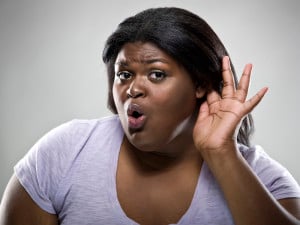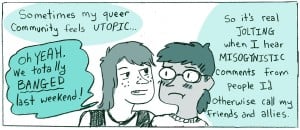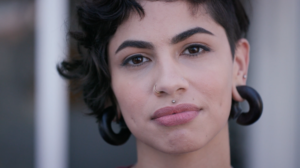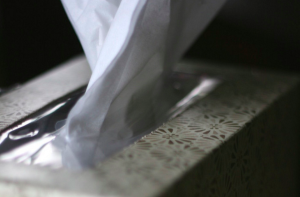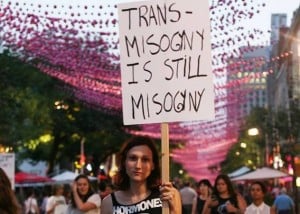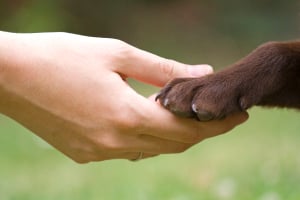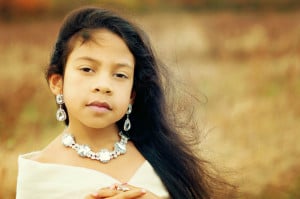
A young person gazing at the camera, long hair blowing in the breeze. Source: Huffington Post
From the start of football season to the Super Bowl, with Halloween and the great fairytale of Thanksgiving in between, this time of year is wrought with stereotypes of Native people.
So when my six-year-old daughter came home recently saying her class had made paper turkeys whose feathers turned into the headdress of the Indian on the flip side, I asked her teacher if I could come in to talk to the class in order to show a less stereotypical (and less animalistic) side to what it means to be Native American today — no leather, feathers, or fringe needed.
I know people like my kid’s teacher mean well, but what they and many others don’t understand is that those paper Indians you’re making with your students, or those paper headdresses kids will wear in the school play, and the stories told about the first Thanksgiving are doing little more than perpetuating harmful stereotypes and racism.
Why are they racist? Because they uphold the systemic oppression that comes with erasure.
To put it another way, the subliminal message – and one that is fortified by pop culture – is that Native Americans aren’t living, contemporary people. To the average American, Natives look a certain way, act a certain way, and are neat props in romanticized timelines of US history.
And if we don’t exist in a modern context, then our issues get overlooked and we begin to question our own identities. That’s the real harm of these stereotypes.
Thankfully, November is also National Native American Heritage Month and offers many opportunities to move past one-dimensional representations. Whether you’re in a first grade classroom like my daughter, cooking in the kitchen for a big feast, or just trying to broaden your perspective, here are six suggestions of how to de-stereotype Native American Heritage Month.
1. Check out MTV World’s ‘Rebel Music: Native America’
One of my family’s favorite musicians to listen to is Frank Waln, a 24-year-old Sicangu Lakota artist from my home state of South Dakota.
If that name means nothing to you, then the second season premier of Rebel Music is a good place to get acquainted with this self-described feminist and other talented Native artists and activists fighting against the destruction of women, culture, the environment, and more.
The show debuts at 4pm ET exclusively on the brand’s Facebook page, and will follow Waln, Nataanii Means, Mike Clifford, and Inez Jasper, who is well known in Indian Country, especially Canada, for her strong musical chops and advocacy work bringing attention to the plight of thousands of missing and murdered indigenous women (#mmiw).
The show is just 30 minutes, but Rebel Music offers Common Core-based curriculum, which is accessible online to classrooms and individuals wanting to extend the show’s lessons on indigenous issues.
Random fact about Rebel Music: Laura Jane Grace of punk rock’s Against Me! is the show’s music director. Squee!
2. Show Your Indigenous Pride and Allyship During the Rock Your Mocs Worldwide Event
Possibly one of the neatest things to come out of social media is Rock Your Mocs, which launched in 2011 and is observed annually by indigenous people and allies across the globe. “Mocs” is slang for moccasins, and this year, the event is being held on 11/15.
Created by 22-year-old Jessica “Jaylyn” Atsye, Laguna Pueblo, the event offers a different, more contemporary platform for those wanting to showcase their Native pride beyond traditional venues, such as powwows.
It’s truly amazing watching my social media timelines blow up with photos of indigenous-made (see #3) fancy footwear paired with everything from traditional regalia to Wall Street power suits.
Wear yours, snap a photo, and tag it #RockUrMocs and #RYM2014.
3. Buy Native This Holiday Season and Decolonize Your Holiday Shopping List
There are few better ways to encourage self-sufficiency in a capitalist society than by supporting local and small businesses.
Native-owned online shops and cooperatives make purposeful shopping easy and highlight authentic Native-made products.
I emphasize the Native-made aspect because so many of the trendy “tribal” items out there in stores like Urban Outfitters, Gap, JC Penney and others use and profit off our images and designs, but not a single hand in Indian Country made the item or the profits.
In addition, many of the items being sold in our image and without our consent have deep, traditional meanings for indigenous people and are offensive when used blatantly out of context.
I’m thinking specifically of headdresses here, people.
Unless you are a tribal leader or respected warrior in a tribe that actually utilized these items (and very few tribes actually wore the kind of headdress so prolific among music festival hipsters), you need to stop wearing anything related to headdresses or war bonnets. Now.
Natives are making and selling everything, from head-to-foot clothing and skin care, to furniture and technology, to food and services.
A few of my favorite fashion boutiques include women-led or managed Beyond Buckskin, RezonateArt, and ButterflyBuffalo. I’m also a big fan of Louie Gong’s Eighth Generation products, which include fashion, but also household items and the beautiful Inspired Natives Project.
Want more ideas? Beyond Buckskin creator, Dr. Jessica R. Metcalfe, Turtle Mountain Chippewa, put together this ever-growing list of Native-owned businesses that can help you “Buy Native” products in every category this holiday season.
4. Let Project 562 Expand Your Views on Contemporary Native American Imagery
For many people, Natives are viewed as people of the past, not present people with a past. The difference is that we’re often viewed in the context of museum exhibits, Hollywood westerns, and whitewashed history books.
Very rarely are we placed in a modern setting.
And when we are, it’s generally to showcase how poor our reservations are, how much crime and violence we experience, and other negative associations. Not that those things aren’t true, but like every other community on this planet, we’re so much more than those surface depictions.
Camera in hand, Matika Wilbur has set out to change perceptions of Native people.
Back in 2012, Wilbur, Swinomish and Tulalip Tribes, embarked on a journey to document the people representing our nation’s federally recognized tribes.
Project 562 refers to the number of tribal nations that were federally recognized in 2012 when Wilbur launched the project. (The count is now at 566 and changes year-to-year based on a number of factors. It is also important to note there are many other tribes in existence that are not federally recognized.)
The point is, the wildly successful crowd-funded project has and will continue to take Wilbur across the United States to showcase contemporary and beautiful Native identities. The photos she has taken already show a side to Native America rarely seen in mainstream media and pop culture.
5. Join the Movement to End Racist Native Representations in Sports
Roughly 4,000 protesters gathered earlier this month in one of the nation’s largest ever anti-mascot rallies during the Minnesota Viking’s matchup against the Washington, DC NFL team.
I can’t adequately describe the pride I felt watching the protest unfold.
I’ve personally advocated for the removal of Native-associated mascots, names, and logos since I was in high school (early 2000s), but the indigenous struggle against these racist images and dictionary-defined racial slurs has been ongoing for decades (see the Suzan Shown Harjo link in #6), despite what some Hollywood A-listers think.
If you’ve been paying attention at all, you know that study after study after study proves that mascots dehumanize Native Americans and are particularly detrimental to Native youth.
Indian mascots are rooted in violence, aggression, and stereotypes that severely inhibit the development of positive Native identities.
Native images – detached heads, racist caricatures, tomahawks/spears/war bonnets, and everything diehard fans bring to the table with makeup, chants, and rival team putdowns – unequivocally place Natives in an entertainment and objectification category no other ethnicity would be forced to tolerate.
To be clear: These images do not “honor” indigenous culture, as is often contended.
This isn’t about being the dreaded “politically correct,” folks. This is about being respectful.
As it is, a name like Redsk*ns does not promote respect. The historical associations of the word are violent and racist; local governments offered bounties for the bloody (red) skins of Indian savages standing in the way Manifest Destiny.
Census numbers show more than five million self-identified Native Americans living in the United States. But even if all of us agreed in a unified effort against Indian mascots (we don’t – lots of Natives support mascots, believing it’s better to be recognized in a problematic way than not to be recognized at all), we’d still be woefully outnumbered by the tens of millions of football fans angered we’re trying to take away their traditions (irony!).
That’s why we need allies to help us as we try to educate the public on the streets and especially on social media. Join us in our efforts to end racism in sports using the hashtags #NotYourMascot, #ChangeTheName, and #NoHonorInRacism.
6. Brush Up on Your Thanksgiving History
Alright, people. It’s not about not being thankful or hating feasts with family and friends. Speaking as someone who will use any excuse to eat good, starchy food with loved ones, there are very few qualms with the reflective nature this holiday has undertaken in modern times.
But the reasons a lot of Natives get riled up about Thanksgiving are varied and legitimate.
First, Thanksgiving, like Columbus Day, is an annual reminder of the genocide and violence Natives experienced (and continue to experience) at the hands of colonizers.
I mean, we created America’s first welfare line for white folks, white folks flourished, and our numbers and land base plummeted to near extinction. It’s hard not to associate the “thanks” your giving to that fact, especially when the holiday’s true origins are willfully ignored by the masses.
Second, and following up on that last part: The “historical” retelling of Thanksgiving has reached mythological proportions, and yet continues to be taught in classrooms as fact.
The time period generally associated with the Pilgrims was a grim one for the new arrivals and for tribes. We’re talking bad weather, starvation, and disease.
Classrooms teach of friendly collaboration and exchange of goods occurring between Natives and the Pilgrims. In reality, it was more like Natives felt sorry for the ill-prepared Pilgrims who knew nothing of the kind of survival skills required in the New World.
In addition, there’s a lot of evidence that the origins of Thanksgiving were founded on the colonists “giving thanks” that God’s will either wiped out neighboring tribes with disease like smallpox or through war and massacre.
For more, check out these articles: A Wampanoag’s perspective on the first Thanksgiving; Cracked.com’s recap; and Christopher Moraff’s 2012 piece, “Should We Rename Thanksgiving ‘National Ethnic Cleansing Day’?” in Philadelphia magazine.
Finally, Thanksgiving lesson plans are rife with stereotypes.
Whether we’re talking crafts in which feather-donning Natives morph into animals (like my daughter’s assignment) or performances where kids are decked out in paper headdresses and war paint, the imagery reinforces problematic representations of Native people, who are rarely — if ever — presented to students as living, breathing, contemporary individuals who represent more than 500 unique sovereign nations.
Instead of the go-to Thanksgiving stereotypes, take advantage of Native American Heritage Month to teach about indigenous people today, our past and present contributions to society, and our challenges and successes.
A great way to do this is to highlight Indian Country’s heroes and leaders every child can look up to, including WNBA superstar Shoni Schimmel and her NCAA champ sister Jude, South Dakota lawmaker Kevin Killer (who just ran a successful campaign to change the problematic name of a county with a high Native population to Oglala Lakota County), and Suzan Shown Harjo and Amanda Blackhorse, the figureheads taking the biggest national stand against racist sports mascots.
***
Misrepresentation and mistreatment of Natives is pervasive in this country. What better time than Native American Heritage Month to start working to change that?
No leather, feathers, or fringe needed.
[do_widget id=”text-101″]
Taté Walker is a Contributing Writer for Everyday Feminism. She is a Mniconjou Lakota and an enrolled citizen of the Cheyenne River Sioux Tribe of South Dakota. She is a freelance journalist who lives in the Colorado Springs area. She blogs at Righting Red and can be reached onwww.jtatewalker.com.
Search our 3000+ articles!
Read our articles about:
Our online racial justice training
Used by hundreds of universities, non-profits, and businesses.
Click to learn more





